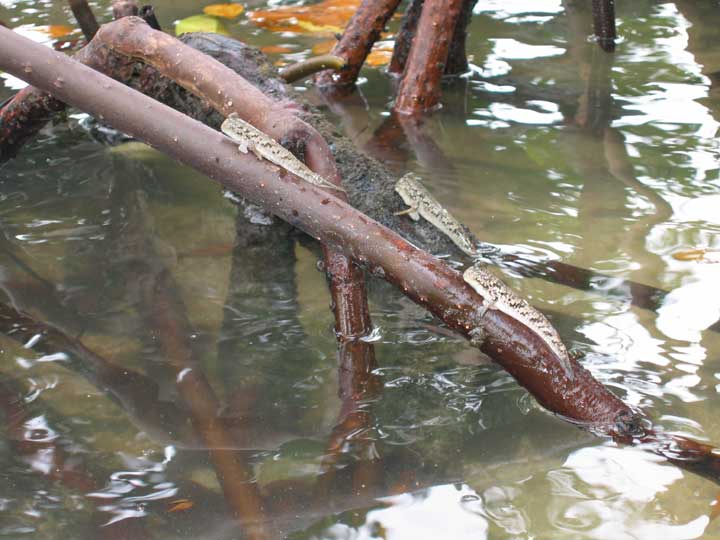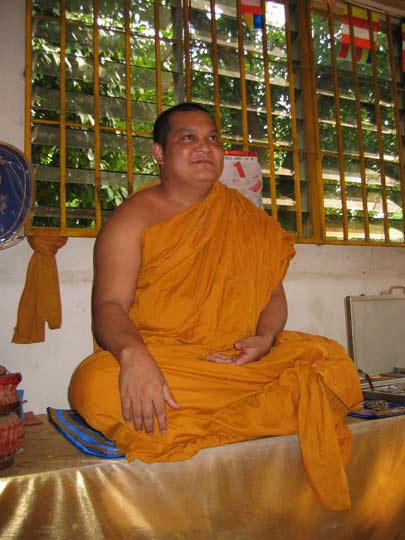Pulau Ubin is an island in the strait between Singapore and Malaysia. It belongs to Singapore, and is the last part of Singapore that has a community living in the oldfashioned kampung style. It is still relatively untouched by modern development, but I am afraid this is changing soon, so hurry up and see it before it is too late. (This was written in 2004.) It is also a great place to ride a bikecycle, and the people here are very friendly.

This picture is taken shortly after takeoff from Singapore's Changi Airport. You see the island Pulau Ubin in the middle, Malaysia to the right (with the factory spewing out smoke) and Singapore to the left mostly hidden in clouds and smoke. Some of the "lakes" on the island are old quarrys now filled with water, used in earlier days to get building material for Singapore.

The best way to get to Pulau Ubin is by bumboat (year 2003, don't know how it is now). Two singapore dollars each way, and a boat leaves once it has 12 passengers. No time schedules. They leave from a small jetty at the end of Changi Beach. The crossing to Pulau Ubin is about 10 minutes. A new ferry terminal is under construction behind in 2003. I wonder how long bumboats will be allowed to operate here. The new ferry terminal did not seem suitable for bumboats to me.

A bumboat crewmember getting ready. Bumboats is the only sensible way to get to Pulau Ubin, and is the first signal to you that the lifstyle and atmosphere on Pulau Ubin is very different from the rest of Singapore. Riding on one of these is a very different experience than on one of the touristy and overpriced bumboats operating from downtown Singapore.

Pulau Ubin village is where the bumboats arrive, and here you find some small restaurants and bike rental shops. During my fisrt visits to the island, the bikes where old and run-down, and you had to check carefully that it was useable. Later, at least one shop has completely renewed their bikes, and you can now get a descent one easily.

There are more trails and roads on Pulau Ubin than you can explore on bike in one day. They vary from small paved roads to typical trails suitable for offroad bikes. The one in the picture above is sonewhere in between. I enjoyed coming back to the island to discover new places. There are some places where you can buy drinks around the island in addition to the restaurants in the village.

This is my bike, a foldable one from Bike Friday, a small bike factory in Oregon USA. Folding and unfolding it in the village received a lot of interested attention from the locals the first couple of times I did it. It rides quite well, even in rough terrain, almost like a regular good mountain bike. It certainly beats other foldables I have tried. The foldable fits my travelling lifestyle, and the trunk of a small car. (In Singapore, they do have small cars, and so did I.)

Wild boars are common on Pulau Ubin, but they tend to stay away from people. This close-up was taken of a mean looking one held in captivity by one of the farmers on the island.

The same farmer also kept this peacock, and sometimes it was keen to display it's assets.

This house always fascinated me, and it's a pity to see it falling down. After seeing it for the first time, I enquired about it at the small National Park Services office on the island. I referred to it as the "English house" and they immediately understood what I meant. It was abandoned by it's owner during WW2, before the Japanese occupied Singapore. The owner never returned. The NPS office told me there was a plan to convert it into a museum. This is a great idea, and a good way of taking care of a piece of Pulau Ubin history.

The English house has a fireplace inside. Strange in an area where the temperature is usually around 30 deg C, and most people use air conditioning year round.

For the nature photographer, ther is a lot to do on Pulau Ubin.

Another subject for nature photographers and others are these fish that also climb trees. They are called mud-skippers, and are more usually found crawling around in the mud at low tide. Maybe trees are a good option at high tide when the mudbanks are flooded?

If low tide occurs at daylight, and is low enough, the National Park Service offers a guided tour of Chek Jawa, the wetlands and muddy areas normally covered by the sea. This reveals a lot of wildlife, some unique to this place only. To protect these, you are only allowed to go here with a guide who knows where to walk safely. The National Park Service office is in the village where the bumboats arrive, and you can check there.

During my last months in Singapore in 2003, the construction of this fence on the side of Pulay Ubin facing Malaysia was started. It was said to prevent illegal immigrants from Malaysia entering Singapore. It certainly prevents those living on this side of the island to get out with their boats, and is a blow to the tiny community there. It's also very ugly and destroys much of the atmosphere that used to be here before.

This munk at a small Buddhist temple on the island gave his consent to have this picture take with a smile after I pointed at the camera. The island also used to have a Mosque, but that has now been demolished. We just have to pray that this buddist temple will be allowed to remain.

This is one of the nicest homes I saw on Pulau Ubin. Very different from living in a 30 story HDB apartment block built by the authorities in Singapore.

Small Malay community on Pulau Ubin.

Some small restaurants and bars are found in the village where the bumboats arrive, but this on can be found in the middle of the island and makes a nice pitstop when riding your bicycle around Pulau Ubin. It won't receive Guide Michelin stars, but what it lacks in style, it has in friendliness and atmosphere.
